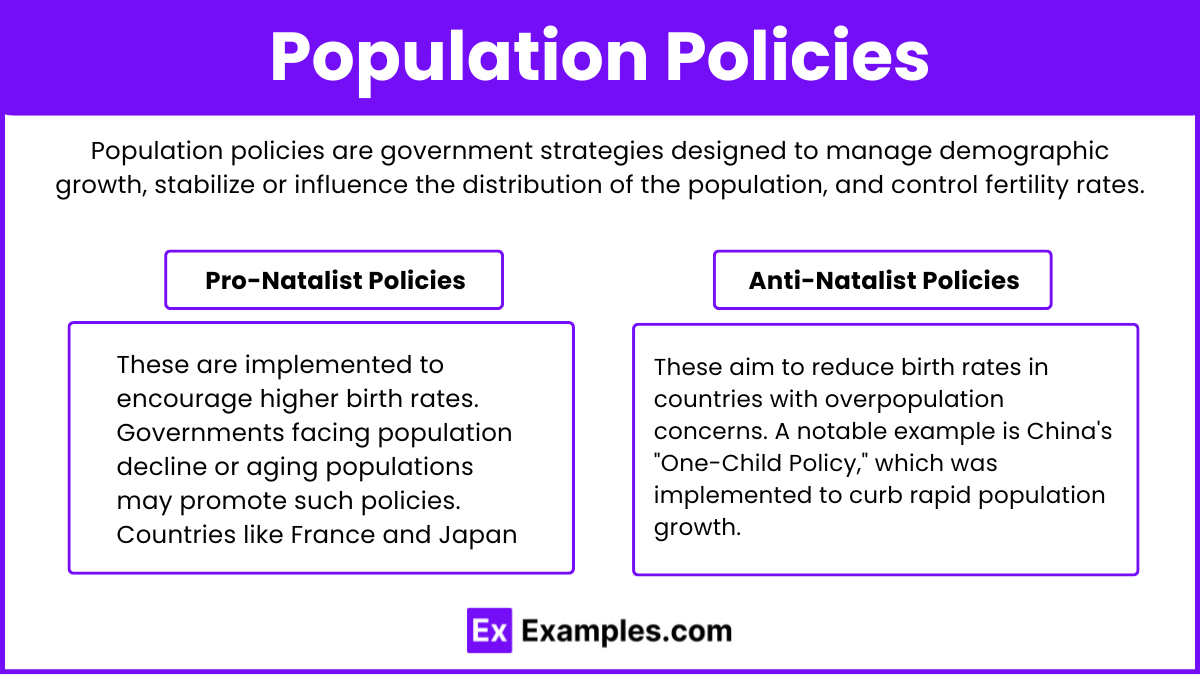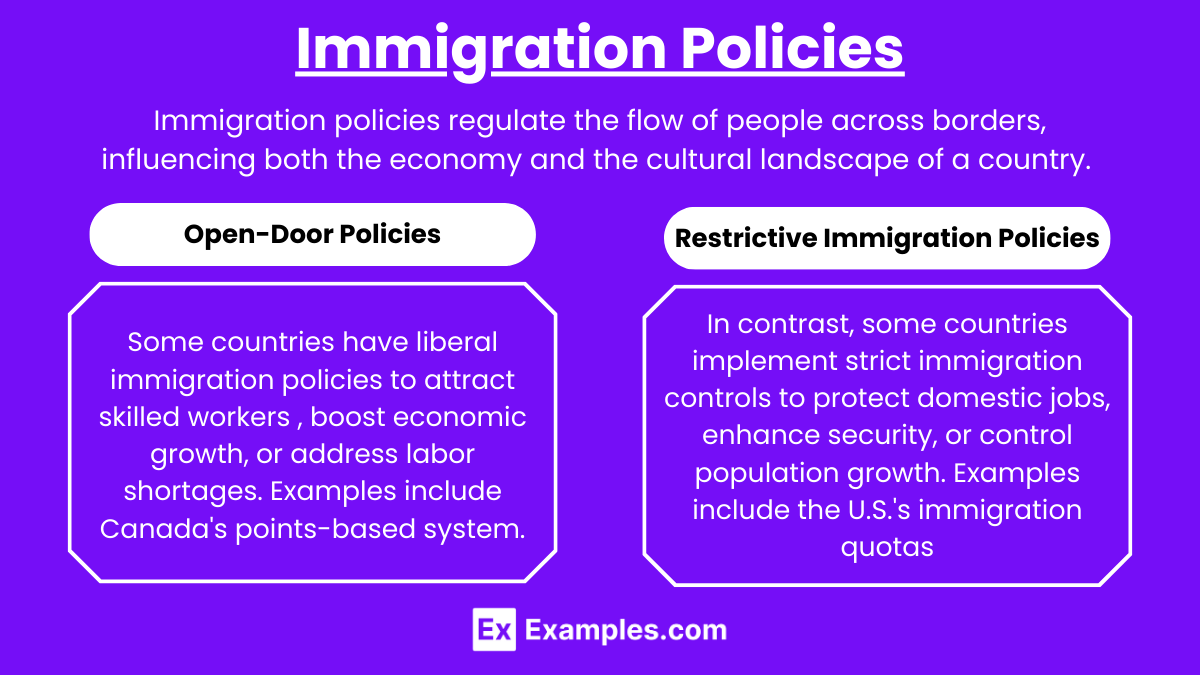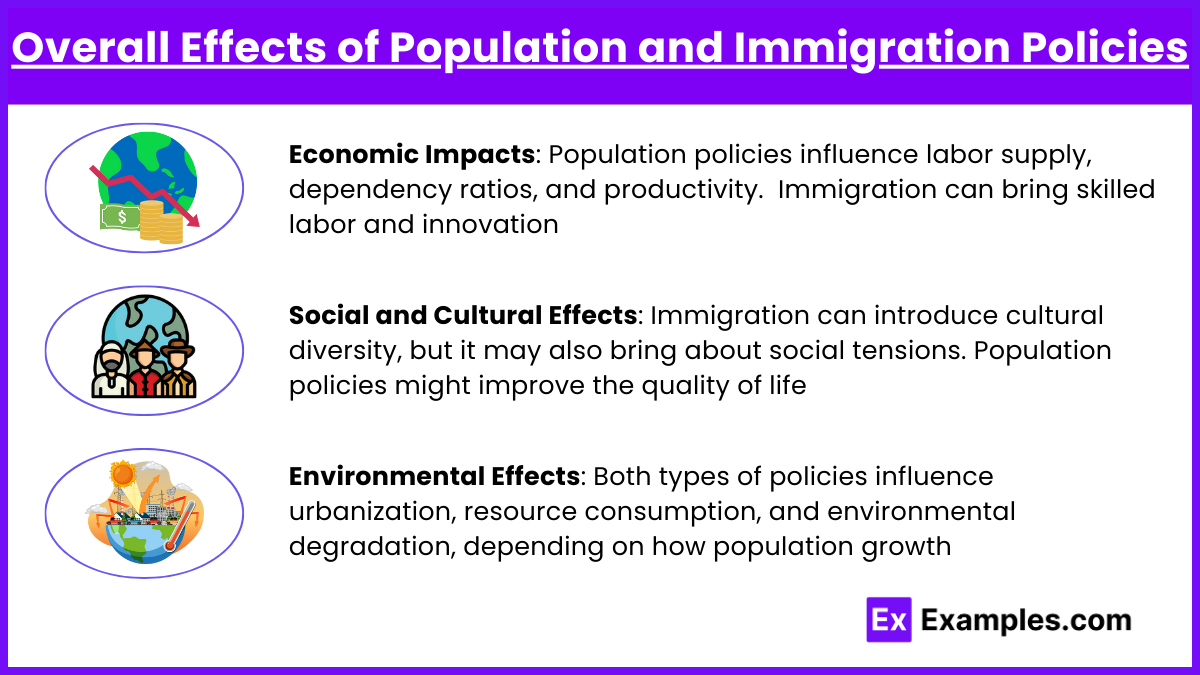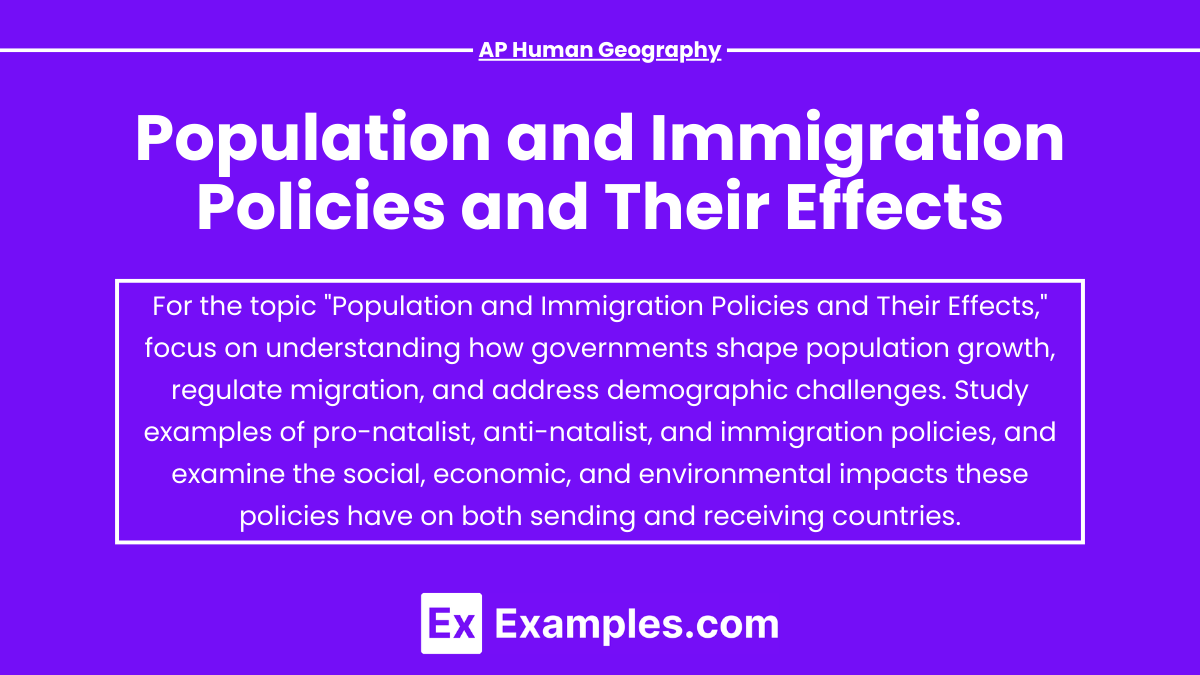In AP Human Geography, population and immigration policies are critical tools that governments use to manage demographic changes and migration flows. Population policies, whether pro-natalist or anti-natalist, influence birth rates and population growth, while immigration policies control the movement of people across borders. These policies impact economic development, social structures, and the environment. By understanding how different nations implement and adjust these strategies, students can analyze the broader effects on society, culture, and geopolitics, gaining insight into key geographic processes.
Learning Objectives
For the topic “Population and Immigration Policies and Their Effects,” you should learn how governments use population policies, such as pro-natalist and anti-natalist measures, to influence demographic changes. Understand immigration policies, including open-door and restrictive policies, and their effects on economic growth, cultural diversity, and social tensions. Analyze the consequences of these policies on labor markets, population distribution, and resource use. Additionally, explore the long-term environmental and social impacts these policies have on urbanization and sustainability.
Population and Immigration Policies and Their Effects
Population Policies

Population policies are government strategies designed to manage demographic growth, stabilize or influence the distribution of the population, and control fertility rates. These policies can be either pro-natalist or anti-natalist depending on the objectives.
- Pro-Natalist Policies: These are implemented to encourage higher birth rates. Governments facing population decline or aging populations may promote such policies. Countries like France and Japan offer financial incentives, tax breaks, and parental leave to encourage larger families.
- Effects: Can lead to a higher birth rate and population growth. Reduces the economic burden of an aging population. Can strain public resources if not managed well.
- Anti-Natalist Policies: These aim to reduce birth rates in countries with overpopulation concerns. A notable example is China’s “One-Child Policy,” which was implemented to curb rapid population growth.
- Effects: Reduced population growth. Long-term demographic issues like gender imbalances and aging populations. May impact workforce availability in future generations.
Immigration Policies

Immigration policies regulate the flow of people across borders, influencing both the economy and the cultural landscape of a country. Policies can range from open-door policies to strict border control depending on a country’s economic needs, security concerns, or political climate.
- Open-Door Policies: Some countries have liberal immigration policies to attract skilled workers, boost economic growth, or address labor shortages. Examples include Canada’s points-based system.
- Effects: Economic growth due to skilled labor. Cultural diversity and enriched societal development. Potential social tension or challenges with integration.
- Restrictive Immigration Policies: In contrast, some countries implement strict immigration controls to protect domestic jobs, enhance security, or control population growth. Examples include the U.S.’s immigration quotas and visa restrictions.
- Effects: Reduced immigration flow can stabilize job markets for native workers. May limit economic growth by restricting labor availability. Can lead to social or political issues, such as xenophobia.
Overall Effects of Population and Immigration Policies

- Economic Impacts: Population policies influence labor supply, dependency ratios, and productivity. Immigration can bring skilled labor and innovation but can also lead to increased competition for jobs and resources.
- Social and Cultural Effects: Immigration can introduce cultural diversity, but it may also bring about social tensions. Population policies might improve the quality of life in overpopulated regions or lead to social inequities.
- Environmental Effects: Both types of policies influence urbanization, resource consumption, and environmental degradation, depending on how population growth is managed.
Examples
Example 1: China’s One-Child Policy (1979-2015)
This anti-natalist policy was implemented to curb China’s rapidly growing population. The government limited most families to having only one child, offering incentives like financial benefits and penalties for those who violated the policy. Effects included a significant reduction in population growth, but it also led to unintended consequences like gender imbalances (due to a cultural preference for male children), an aging population, and a shrinking workforce, which now poses economic challenges for China.
Example 2: France’s Pro-Natalist Policy
France implemented policies to encourage higher birth rates due to concerns over an aging population and a declining workforce. The government offers incentives such as paid parental leave, subsidized childcare, and financial bonuses for larger families. Effects have been an increase in birth rates and a more balanced demographic structure, helping to mitigate the economic strain of an aging population. This policy also supports gender equality in the workplace by making it easier for parents, particularly women, to balance careers and family life.
Example 3: Canada’s Points-Based Immigration System
Canada has an immigration policy that prioritizes skilled workers through a points-based system, considering factors like education, work experience, and language proficiency. This open-door policy aims to attract immigrants who can contribute to the economy. Effects include boosting economic growth, addressing labor shortages, and increasing cultural diversity. However, there can also be challenges in integrating immigrants into Canadian society, particularly in ensuring access to jobs and services for all newcomers.
Example 4: Germany’s Guest Worker Program (Gastarbeiter)
In the mid-20th century, Germany introduced a policy to bring in foreign workers (primarily from Turkey and Southern Europe) to fill labor shortages during its economic boom. While these workers were initially expected to return to their home countries, many stayed and became long-term residents. Effects included economic benefits from the influx of labor, but the program also led to social tensions around integration, cultural identity, and xenophobia. Germany continues to address these challenges through policies that support multiculturalism and integration.
Example 5: Australia’s Immigration Restriction Act (1901, White Australia Policy)
Australia’s early 20th-century immigration policy was explicitly designed to limit non-European immigration and maintain a predominantly white population. This policy, known as the White Australia Policy, was aimed at preserving European cultural dominance and limiting immigration from Asia. Effects included a lack of cultural diversity for much of the 20th century, but the policy was dismantled in the 1970s. Today, Australia has a more multicultural society, though the legacy of the policy still influences immigration debates and racial tensions.
Multiple Choice Questions
Question 1
Which of the following is an example of a pro-natalist policy?
A) China’s One-Child Policy
B) France’s financial incentives for families with more children
C) India’s sterilization campaigns in the 1970s
D) Japan’s immigration restrictions
Correct Answer: B) France’s financial incentives for families with more children
Explanation: A pro-natalist policy encourages higher birth rates to counter population decline or aging populations. France’s government offers financial incentives, tax benefits, and paid parental leave to encourage families to have more children, aiming to boost its population growth. In contrast, China’s One-Child Policy (Answer A) was an anti-natalist policy designed to reduce population growth. India’s sterilization campaigns (Answer C) aimed to limit population growth, while Japan’s immigration restrictions (Answer D) address foreign population control rather than increasing births.
Question 2
What is a likely effect of restrictive immigration policies on a country’s economy?
A) Increased economic growth due to a larger labor force
B) Potential labor shortages in certain industries
C) An immediate rise in birth rates among the native population
D) Reduced dependency on technological innovation
Correct Answer: B) Potential labor shortages in certain industries
Explanation: Restrictive immigration policies limit the number of people entering a country, which can lead to labor shortages in industries that rely on immigrant labor, such as agriculture, construction, and healthcare. This can slow economic growth (Answer A) because businesses may struggle to find enough workers. Restrictive immigration policies do not directly cause an increase in birth rates among the native population (Answer C), nor do they reduce the need for technological innovation (Answer D); in fact, they might increase reliance on technology to compensate for labor shortages.
Question 3
Which of the following is an unintended consequence of an anti-natalist policy like China’s One-Child Policy?
A) Decreased gender imbalance
B) Increased aging population
C) Higher birth rates in urban areas
D) Increased immigration rates
Correct Answer: B) Increased aging population
Explanation: Anti-natalist policies like China’s One-Child Policy effectively reduce birth rates, but over time, they also lead to a disproportionately aging population, as fewer young people are born to support the elderly. This creates long-term challenges for the workforce and social support systems. A gender imbalance (Answer A), where males outnumber females, was another unintended consequence of China’s policy, but the policy did not decrease the gender imbalance. Higher birth rates in urban areas (Answer C) and increased immigration rates (Answer D) are not typically associated with anti-natalist policies.


